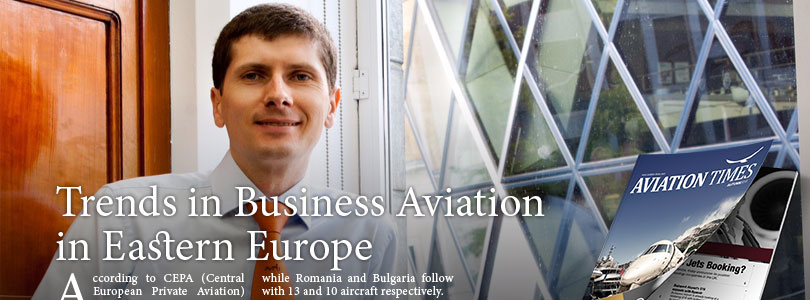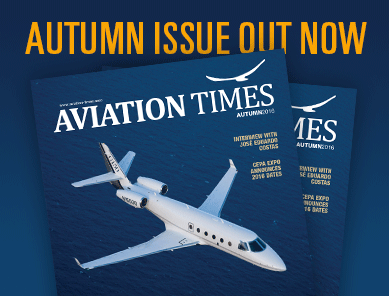Trends in Business Aviation in Eastern Europe
At EBACE 2015 EBAA CEO Fabio Gamba described Eastern Europe as the “most challenging region right now”, he was describing the situation resulting from the Ukrainian crisis. Gamba advised that countries that border Ukraine; Romania, Bulgaria, Poland and Lithuania, had seen the most significant falls in business aviation traffic. The sector seems now to have weathered the worst of the storm and there are hopes it can possibly look to the future with optimism. Or can it? The aftermath of the Ukrainian crisis is still strongly felt in a number of Central and Eastern European economies, and there is speculation that some parts of Europe could slide back into recession.
According to CEPA (Central European Private Aviation) in recent years the number business aircraft in Eastern Europe has grown considerably, CEPA advises that the fleet of business aircraft in the region has grown ten times larger since 2000. In terms of aircraft charter activity the region represents a market of more than €500 million.
Aircraft sales in the region remain resilient, last year 213 aircraft sales transactions took place in Eastern Europe (this includes, sales, purchase, lease in, lease out or change of ownership). In total 107 aircraft came in to region and 106 aircraft left the region. If 2015 continues to follow this trend the estimated number of transactions could grow by 5% on a year to year basis.
Despite the turmoil in the business jet market during recent years the total number of Business Aircraft in the Eastern European Region has continued to grow. Currently there are approximately 360 aircraft either based or operating in Eastern Europe. Of these 108 are based in Russia with the Ukraine having 30 aircraft and Kazakhstan 27 aircraft. Outside of Russia and the CIF states the Czech Republic leads the way with 44 aircraft based there. Poland has 22 aircraft while Romania and Bulgaria follow with 13 and 10 aircraft respectively.
The Baltic States have seen an increasing business aircraft activity in recent years with Estonia having 16 active aircraft, Lithuania 10 and Latvia 5. Other significant countries include Slovakia with 12 aircraft and Hungary with 9 aircraft.The market for Business Aircraft in Eastern Europe has remained stable with sales of used aircraft continuing as normal and deliveries of new aircraft being posted as 14 new private jets arriving during the last 18 months. These include 5 from Embraer along with additional aircraft from Bombardier and Gulfstream. Within Eastern Europe trading levels of aircraft have remained stable, in 2014 107 new aircraft arrived into the region while 106 were sold outside the region, a net gain of 1 aircraft. So far in 2015 67 new aircraft have been bought by Eastern European operators while 65 used aircraft have been sold to owners outside Eastern Europe, therefore the region currently has a net gain of 2 new aircraft
The level of aircraft transactions in Eastern Europe fell slightly after the global economic crisis of 2008 but since then this has continued to increase. Estimates for 2015 are that this could be the most successful year yet with an estimated figure of 115 aircraft coming into service in Eastern Europe.
Year on year analysis of aircraft transactions from 2009 shows that from 2009 to 2013 more new aircraft came into the region than were being transacted and sold to countries outside. Therefore during those 4 years there was a net year on year gain in the size of the fleets of Eastern European aircraft operators. However in recent years, despite the fact there have been more aircraft transactions, the number of aircraft being brought into the region is very similar to the number of aircraft being sold to countries outside Eastern Europe. Therefore the net gains have levelled off during the last 2 years.
When taken in context, and compared with other regions of the world, the last 10 years have seen considerable growth in the number of business aircraft operating within Eastern Europe. However this is largely because in the early stages the number of aircraft was relatively small so as the market grew, the size of the fleets of aircraft grew to meet the need for more aircraft. The level of aircraft transactions has stabilised during the last couple of years as fleets have grown to meet and equal market requirements. However it must not be forgotten that recent political events and restrictions have had an impact on the level of business aircraft activity in the region and these are key factors behind the stabilisation or levelling out of growth throughout the region. If it had not been for the recent unrest it is possible that growth could have been higher. Analysts predict that it is unlikely that the levels of growth will return that were seen when the market was relatively new and demand was high, however it is anticipated that, with stability in the region, more moderate levels of growth will return in the near future.
Incentives to buy new aircraft such as discount pricing, marketing packages and maintenance packages have all helped to keep the level of aircraft sales relatively stable. The turnover of aircraft has meant that resale values have fallen. This has led to some very attractive aircraft pricing for new entrants into the Business Aircraft market that are seeking to buy high quality used business aircraft. Prices for used aircraft have fallen continuously since 2008 which has led to an oversupply of the market leading to further price reductions. However this has meant that new entrants are entering the market and are taking advantage of the availability of aircraft at relatively low prices. This accounts for the stability in the overall number of aircraft being used and operating throughout Eastern Europe and explains why growth is expected for the foreseeable future.
Speaking about the report Marian Jancarik, Sales Director of Colibri Aircraft commented “I am very happy with what we have found, the report is very positive and I am confident that stability in the region, combined with an upturn in economic growth, will see an increase in aircraft sales and aircraft fleets in the region. The growth pattern has been stable through some very difficult times so once we see even minor improvements in the economies of Eastern Europe I am sure this will bring even more new entrants into the market. This is a market that has only started to develop during the last 10 years so the growth potential is still enormous. The size of the countries of Eastern Europe and the distances involved means that business aircraft are the best solution for travel throughout the region and to destinations in Europe and beyond.”
Publishing or copying the content of AVIATION Times without a written electronic permission is strictly forbidden. If you have any information, tips, videos, photos or your press releases for us contact us at news@aviation-times.aero.
AVIATION TIMES © Copyright 2012 - 2025








